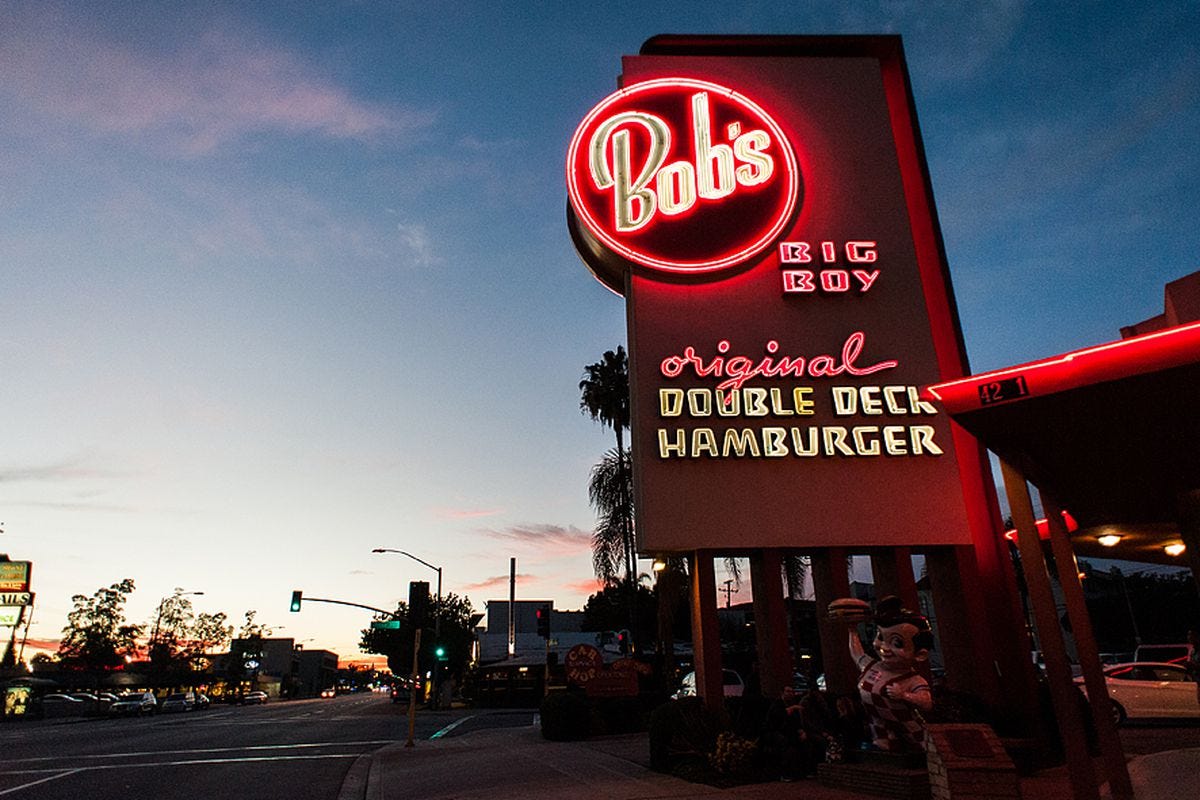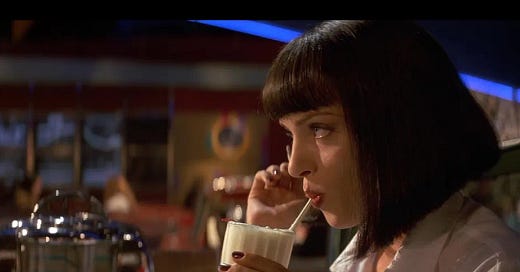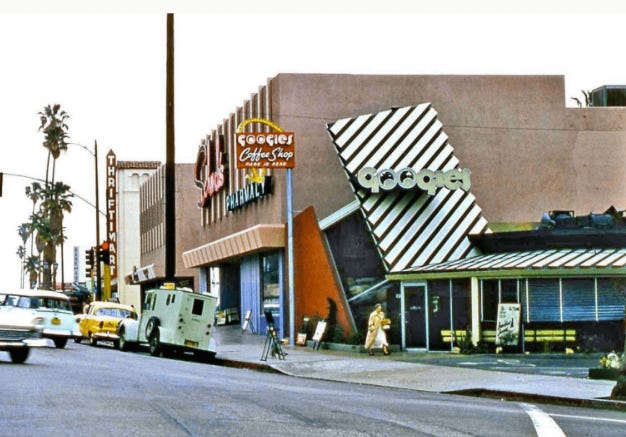Big things ahead, ladies and gentlemen, Big Things Ahead! Eighty-eight miles-per-hour on a collision course with The Future. Starbursts and neon lights. The American Dream sent to space with a blast of rocket-fueled Rock & Roll and diner doo-wop, leaving behind that old-timey Razzmataz.
Googie hit the scene with a nuclear Pow! and exploded the gates off of pop culture with starburst glimmers and the light of thousands of humming neon signs. To the dismay and upturned noses of prestige architects and rule-followers, Googie was for the people, of the people, by the people. It was all-American. And it changed everything.
Googie epitomized the crashing together of America from its beginning, just a stepping stone in the timeline of a nation forever teetering between boldly forging ahead to places unknown and strange and cultivating the rich traditional history of the places and eras it leaves behind. Palaces are built on the ashes of treasured memories — the alchemy of golden nostalgia and chrome flourishes of perpetual futurism and techno-optimism without the dystopian feel of doomer futurism.
Mostly manifested in commercial buildings like coffee shops (the name “Googie” comes from Googie’s Coffee Shop, built in 1949) diners, bowling alleys, and movie theaters. Googie was the spaceship atomic new wave building style as 1950s Americans envisioned the future.
Architect and author Alan Hess describes it in an interview for Smithsonian Magazine:
Googie is undeniably the super-aesthetic of 1950s and ’60s American retro-futurism — a time when America was flush with cash and ready to deliver the technological possibilities that had been promised during WWII. “I really feel that Googie made the future accessible to everyone,” Hess says. As he explains it, Googie was an unpretentious aesthetic meant to appeal to the average, middle-class American: “One of the key things about Googie architecture was that it wasn’t custom houses for wealthy people — it was for coffee shops, gas stations, car washes, banks… the average buildings of everyday life that people of that period used and lived in. And it brought that spirit of the modern age to their daily lives.
Despite this flash-bang style, Googie borrowed from what came before, namely Art Deco and Streamline Modern merged with Frank Lloyd Wright’s organic, prairie style. John Lautner, who designed Googie’s Coffee Shop, was a protégé of Wright.
Googie was flashy and bright and eye-popping by design. It was born in Southern California as part of the burgeoning car culture and sprawling cruising scene (We see you, American Graffiti). A place had to stand out to catch the eye of hot-rodders and scene-makers driving through the loop. And you couldn’t miss a Googie — these palaces of the Average Man inviting you in for a cup of coffee, spin at the jukebox, or a night at the bowling alley.
It was meant to evoke the Space Age futurism and brightness of unhindered possibilities. But it was also grounded in a naturalistic mode that new building technologies made possible. Merged with the sunny, dry, Southern California climate allowing for the lines between the outdoors and the sky and inside functionality and purpose to blur.
It was soaring, with cantilevered rooftops, geometric shapes, boomerangs, neon lights, exaggerated fonts, and parabolas. Think of the “Welcome to Las Vegas” sign, the oldest remaining McDonald’s restaurant, and Bob’s Big Boy diners. Tomorrowland at Disneyland, and the Theme Building at Los Angeles International Airport. America was headed to the moon, but until we actually set foot on it, we could grab a blue plate special or a silver goblet milkshake at a Googie.
But the critics and gatekeepers didn’t like this decentralized, pop-culture optimism and commercialistic creativity that Googie represented. In the February 1952 issue of House and Home magazine (page 86), critic Douglas Haskell very thinly veiled his contempt for the new movement adopting an overly sarcastic tone, ending it, “So something better than accidental discoveries might come even from Googie. It's too bad our taste is so horrible; but it's pretty good to have men free…”
Oddly, the immediately following pages feature a Lautner spread highlighting the brilliant residential architecture he designed in Hollywood, the stuff of dreams and bottomless tacky-wacky to the stodgy, unimaginative rule-makers. How dare anyone defy them?
This is where the story gets good.
Nothing built from remnants and scraps of the past was reimagined in such an outrageous, wild, uninhibited Googie way that this new future suddenly made N-O-W in post-WWII America. Every man has his story, and every place has its mysteries with effervescence just bottled up and shook until we cannot contain them anymore. The great stories must be told. America is full of them.
But what happens when we’ve been shaking that bottle of Coca-Cola and some pasty-faced guy comes around the corner with his badge and rule book, shakes his untouched finger at you, and says, “No! Not here with that little bomb of excitement. It’ll disturb the neat and orderly. Who knows what damage it could do? Why, it might give other people ideas.”
Two choices: lower your eyes and mumble some nonsense and scuttle away into the safety of the shadows or crack open that bottle with the full force of might and will and let those ideas explode and change the world.
Googie was 100 percent American. And it changed the world.
Googie dreams invaded America’s reality for about 25 years. But the very dreams that inspired the design — and the nation — was also its undoing. With the Apollo 11 space mission and the moon landing, the dreams crashed to earth, and eventually, what was fantastic became a humdrum.
For a few decades, America paved over these Space Age paradises with brown earth tones and beiges. The fear-mongering of anti-nuclear energy Mother Earth hippies and 1970s malaise washed over the nation in attitude and aesthetics.
But America wouldn’t be lost in the drudgery forever. It’s not in our nature for people who took risks venturing into the uncharted, wild, beautiful West. There must be a vision and a refusal to comply with predetermined outcomes and prohibitive rules around imagination and creativity and hope. If it weren’t for the dreamers and the risk-takers, there wouldn’t be America. And one of the shining examples of America’s refusal to settle, be boxed in, and drown in the safety of beige is Googie.
Googie already permeated the culture, raining down in pixels and celluloid, easing into vinyl booths and leaning against pastel, chrome-lined counters.
Quentin Tarantino, cinema’s Golden Boy, new wave, Googie-style 1990s groundbreaker explained the importance of generational culture (reflected in many of his early films) in an interview with Joe Rogan in 2021:
We had the Saturday morning cartoons that we dug, we had “Schoolhouse Rock,” we had all the TV shows we liked, we had “Speed Racer,” we had all these kind of things, and they meant something to us. And kids back then, who if their parents didn't let them watch TV at a certain point, the parents might have actually had the best intentions, but they were actually robbing their children of the pop cultural glue that's going to tie them to their generation when they get older. And so we had the ABC movies of the week, we had all that stuff, and we had fucking great movies.
We had all that. And so when we got older, it was about talking about that stuff. That was what was worth talking about.
Tarantino and another visionary filmmaker, David Lynch, incorporated these ideas into their movies and it was seamlessly part of the background just as these places were in our lives.
In Pulp Fiction, Vincent Vega (John Travolta) and Mia Wallace (Uma Thurman) patronize a retro diner. It’s an homage by director Tarantino to the 1950s, from the booths reminiscent of the 1968 Elvis film “Speedway” to the Ed Sullivan-ish emcee and celeb-impersonating servers. Behold, the Five Dollar Milkshake (contains explicit language):
Tarantino used the now-demolished Hawthorne Grill for the “Pulp Fiction” bookended diner scene; Johnie’s Coffee Shop, also in Los Angeles at Wilshire Boulevard in “Reservoir Dogs.” Johnie’s is also the backdrop in “Miracle Mile,” Ed Norton shows up there in “American History X,” and where the Dude discusses the severed toe with Walter in the Coen Brothers’s 1998 film “The Big Lebowski.” (Lebowski is a Googie showcase. In addition to Johnie’s, Jackie Treehorn’s house and the Hollywood Star Lanes bowling alley are all Googie.) Even a gothic Googie aesthetic shows up in Tim Burton’s “Edward Scissorhands”: the Southport Shopping Center in Lakeland, Florida, with its soaring arch, glowing signage, and cantilevered top.
There’s a reason Bob’s Big Boy became the memorial resting place after Lynch’s death. These ordinary places and routines and backdrops hold us together, remind us of a common cause, and, in the case of Googie, urge us to do great things, shake the world, and chase our dreams.

At the Hudson Union Society, Lynch talked about his affinity for Bob’s Big Boy, (specifically the one in Burbank designed by Wayne McAllister, who also reimagined Las Vegas from a wild west town to mid-century modern/Googie playland in his design of the Sands Hotel):
I went there because I like to have a chocolate milkshake and there was a silver goblet shake; it wasn’t really ice cream. It was a thing that they called a Taylor machine and it would get cold and they’d pull the lever and it would come in kind of a tube of ice cream and fill this goblet. … If you came during lunch, they made so many of them, it never would get cold enough to be ice cream, it would be like soup. So I would go later and it would be cold enough, it would just be just right. And if I went later, I’d be so hungry, you know what I mean? I had these things for seven years with a cup of coffee and I would write on the napkins. It was like having a desk. You need paper, there’s a piece of paper and you write on it when you get ideas.
We go back to it again and again after waves of dulled neutral tones and shades of beige. Googie might have seemed like an artistic expression of a white-hot comet falling into America’s dreams with a burst of neon and upswept concrete, but it was about Americans daring to reach up to the stars and claim their place among them. Not just the rich and powerful but the work-a-day Joe and Jane figuring out 20th-century life.
We’re always reinventing ourselves, pushing the boundaries of possibilities, but with the past always haunting these soaring dreams. Rightly so. Because idolizing an idealistic past keeps us striving toward a more perfect version of ourselves. A more “perfect union,” of tradition and a bold, adventurous, gate-breaking future.
Tarantino, maybe unintentionally, comes around to this in the Rogan interview:
I remember I'm like sitting at Video Archives and I'm saying, well, I want to do shit like that when I'm making movies. And then one of the guys said, “Well, they won't let you, Quentin.” And my answer was, well, who's they?
Who are they to tell me what I can and can't do? And at the end of the day, the proof is in the pudding.
I never let them stop me. I did what I wanted to do. And by doing what I wanted to do, we changed the 90s.
The cowardly thing to do when they say, “You can’t do that,” is retreat. To hide behind the skirts of bureaucracy and rule books. The American thing to do is double down and do the thing. Consider it a challenge: a duel to the death for the soul of the human spirit.
It took me a long time (how long, you ask? Well, a lady never reveals her age) to see what was all around me and to push off the expectations of a pre-written future and dull tones of “smart people” who don’t care about me or even the rules they write! Their interest belongs to self-preservation and hiding in the faceless, drab sameness of the crowd, and within the boundaries of their fists on the levers of power.
Gas stations and bowling alleys. Diners and dry cleaners. It’s the smallest slice of Americana electric neon amazement hiding in plain sight. But in that moment I saw my reflection as a thousand lights in the blackness. And I blinked, and it was gone.
Googie was outmoded by achieving its dream. Isn’t that a life well lived? As a comet blazing through the sky. A fireball of fantastic dreams burned out by reaching earth. Dreams, realized. And now we reinvent ourselves as one step forward for mankind and what comes next for humanity. Never stop dreaming. Never let people who think they know everything — who write the rules — cage imagination and stifle wonderment. They are the cowards. And they want you to join them. They delight in their fear and anger and sameness.
Don’t give them the pleasure. Order the $5 milkshake.
Thanks for indulging a silly post for a silly-minded dreamer. Someday, I’ll figure it out and find my way.
Sincerely, Jenna








Jenna,
As I was reading your essay, my memory bank started flashing — knowing ‘Jenna knows of Wildwood, NJ’ and the contemporary political rallies held on its beaches. I wondered — does Jenna know of Wildwood’s illustrious architecture. I continued reading…
When the ride ended I drove further on to Dan’s excellent comment — BAMB, Dan nailed it — Wildwood is Doo Wop! And it isn’t paved over or ‘painted beige.’ Even the local Mickey D’s has ‘the vibe.’
You had me at “We’re always reinventing ourselves, pushing the boundaries of possibilities.” Another great essay of America’s continuing imagination.
Thank you for sharing your imaginative neon writing & please don’t keep your keyboard idling — ‘great stories must be told…’
Much has been written about the Fabulous ‘50’s and its unique cultural quirks. World War II had crushed and erased mich of the American culture Everyone wanted a fresh start.
What made this cultural revival different was the influence of teen-agers. We were the first generation with allowances, thanks to the post-war economic boom. Millions of us had weekly cash-flows looking for entertainment; we had no financial obligations Drive-up diners, bowling alleys, drive-in movies popped up with new architectural designs to attract this emerging market. The money we earned raking leaves, shoveling snow was converted into French fries and Cokes at alarming rates.
Rock ‘n’ Roll came along and blew the doors open and completed the remaking of our culture. Thank you, Chuck Berry.